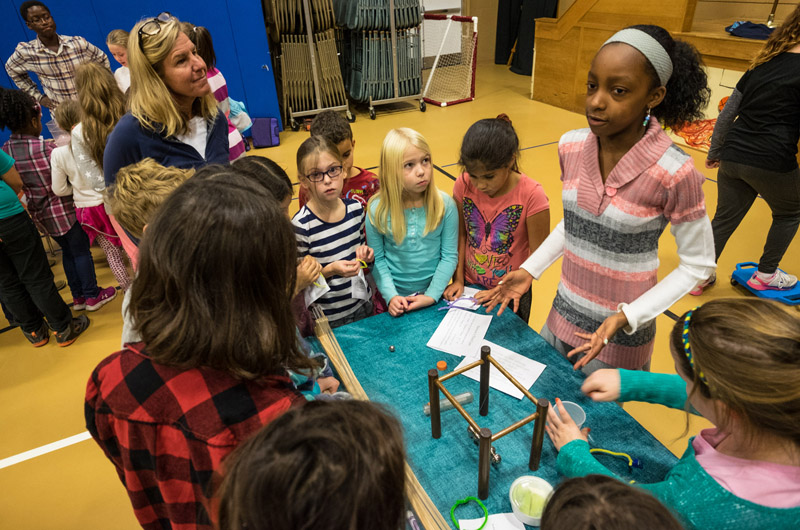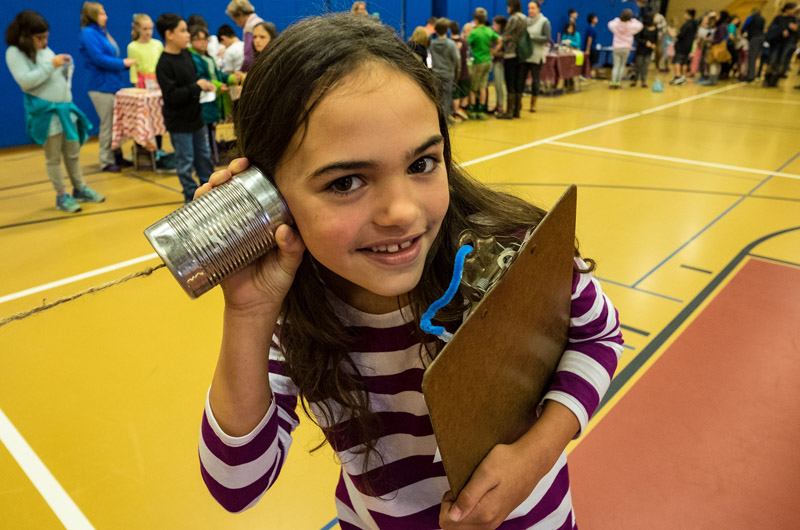Martha’s Vineyard Public Charter School student Mattie Wolverton, age 9, stepped up on a block and placed both hands on the Van de Graaff generator. Many more students gathered around him, eyes wide and shrieking with delight as his curly hair began to stand up on end. Mattie was experiencing kinetic energy at the Edgartown School’s Energy Carnival. Fifth graders Quinn Filiault and Joao Simoes were manning the Van De Graff station, a very popular table at the carnival.
Joao explained to other students how a moving belt attached to an insulated column accumulated electric charge on the hollow metal globe.
“This is what happens when you take your hands off,” he said. He held his arm a couple of inches away from the ball. Quinn flipped the switch and a blue white charge of electricity zapped from the ball to Joao’s arm.
The Energy Carnival was organized by Edgartown School science teacher Kara Gelinas. Before she taught science, Ms. Gelinas worked with Cape Light Compact which held similar carnivals all over the Cape. She decided to introduce the carnivals to the Edgartown School to help students engage with science.
This year, students from Vineyard Haven, Chilmark, West Tisbury and the Charter School attended the carnival, which stretched through the entire morning. Sixteen tables were set up around the school gym, each manned by two to three Edgartown School students who taught lessons in types of energy and energy transfer.
“It’s their curriculum and the best way to learn is to teach,” said Ms. Gelinas. The fifth graders had been studying energy for about a month before they organized their booths.
“What school are you from,” an Edgartown student yelled down from the second floor to the lobby where a line of students was entering.
“West Tisbury,” the students said.
At the carnival there were tables demonstrating Newton’s Third Law, conduction and convection, solar energy and sound energy. At one table, a magnet under a piece of paper created a force field. At the Newton’s Third Law table, a girl explained potential energy to a group of students. She pulled out a sphere from a Newton’s cradle.
“The higher something is the more potential energy it has, because it has more potential to drop,” she said. The ball dropped, hitting the other balls, sending the outermost one swinging in the other direction.
At the Sound Energy table, students Brooke Ward, Audrey Polleys and Leiliane Dias demonstrated different ways sound energy could be seen.
“Sound is vibrating molecules,” said Brooke, banging a tuning fork against the table and then holding it over a cup of water.
Audreye demonstrated how sound moves in waves with a slinky. Leiliane helped a pair of students use a tin can telephone, the sounds of their voices traveling down a taught string from one can to the other.
At each station, the visiting students collected a white bead. They strung the beads onto pieces of pipecleaner to create a bracelet. The beads were UV reactive and in sunlight would turn different colors, Ms. Gelinas promised.
Ms. Gelinas said she hopes the carnival creates excitement around learning about energy for all the students.
One boy, wearing a solar system shirt, certainly seemed to have caught some excitement.
“I’m electric,” he exclaimed, stepping away from the Van de Graaff machine and reaching out to shock other students.






Comments
Comment policy »